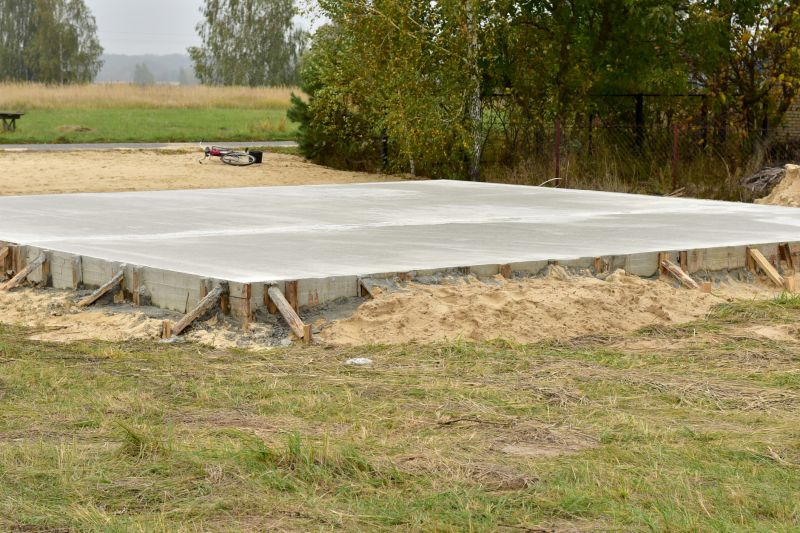Top-Rated Products To Simplify Concrete Installations
Choose from proven tools and materials designed to improve workflow and ensure lasting concrete structures.
 Concrete installations are a fundamental aspect of many construction and renovation projects in Red Oak, TX. Whether building a new driveway, patio, walkway, or foundation, selecting the right products ensures durability and a professional finish. The process involves various materials and tools designed to prepare, pour, and finish concrete surfaces effectively. Properly chosen products can help achieve smooth, level, and long-lasting results, making them essential for both DIY enthusiasts and professional contractors.
Concrete installations are a fundamental aspect of many construction and renovation projects in Red Oak, TX. Whether building a new driveway, patio, walkway, or foundation, selecting the right products ensures durability and a professional finish. The process involves various materials and tools designed to prepare, pour, and finish concrete surfaces effectively. Properly chosen products can help achieve smooth, level, and long-lasting results, making them essential for both DIY enthusiasts and professional contractors.
Top Overall Option
Concrete Forming and Finishing Kit
A comprehensive forming and finishing kit provides a versatile set of tools and materials suitable for various concrete projects. It typically includes forms, trowels, floats, and curing compounds, allowing users to handle everything from small slabs to large surfaces. This all-in-one solution promotes efficiency and consistency in concrete installation tasks.
Types of Products For Concrete Installations
Concrete Mixes and Cements
Pre-mixed and custom-blend concrete mixes designed for different strength and setting time requirements.
Reinforcement Materials
Rebar, wire mesh, and fiber reinforcement to improve concrete strength and crack resistance.
Form Liners and Forms
Molds and forms that shape the concrete surface and edges for various designs and dimensions.
Admixtures
Chemical additives that modify setting time, workability, and durability of concrete.
Curing Compounds
Products that retain moisture and promote proper curing for optimal strength development.
Concrete Vibrators
Tools used to remove air bubbles and ensure proper compaction of poured concrete.
Finishing Tools
Trowels, floats, edgers, and hand tools for smoothing and detailing concrete surfaces.
Surface Sealers
Protective coatings that enhance durability and appearance of finished concrete.
Expansion Joints
Materials used to allow for movement and prevent cracking in large concrete slabs.
Concrete Pumps and Buckets
Equipment facilitating the transportation and placement of concrete in various locations.
Concrete Repair Products
Patch and crack repair compounds for maintaining and restoring concrete surfaces.
Edge and Corner Tools
Specialized tools for shaping and finishing edges and corners of concrete slabs.
Surface Texturing Products
Stamping mats and texture skins for decorative finishes.
Concrete Heating Cables
Heating elements used to accelerate curing in cold weather conditions.
Popular Choices
Handheld vibrators for compacting fresh concrete in small to medium projects.
Concrete mixes enhanced with polymers for improved adhesion and flexibility.
Insulated covers that help retain moisture and maintain consistent curing conditions.
Concrete containing fibers to reduce cracking and improve structural integrity.
Tools and mats for creating stamped patterns and textured surfaces.
Products applied to molds and stamps to prevent sticking and facilitate clean finishes.
Tools for shaping edges and creating control joints to manage cracking.
Coatings that provide moisture resistance for concrete exposed to weather.
Fast-curing mixes suitable for quick project turnaround.
Additives or coatings that enhance traction on concrete surfaces.
High-strength adhesives used for patching and restoring damaged concrete.
Flexible materials that accommodate movement and prevent cracking.
Chemical agents that delay surface setting for decorative exposed aggregate finishes.
Portable mixers for small to medium batch production.
In concrete installation, the preparation stage is critical. This includes selecting appropriate forms, reinforcement materials, and setting up the work area. During the pouring phase, products such as concrete mixes and admixtures come into play, influencing the workability and setting characteristics. Finishing tools, including trowels and floats, are used to create the desired surface texture. Additionally, curing products help maintain optimal moisture levels, ensuring the concrete gains strength and reduces cracking over time.
Given the wide range of available products, it is important to consider compatibility with specific project requirements. Factors such as load-bearing capacity, environmental exposure, and aesthetic preferences influence product selection. Proper safety equipment and accessories also contribute to a smoother installation process. Investing in quality materials and tools can lead to better outcomes and longer-lasting concrete structures, making informed choices essential for successful installations in Red Oak, TX.
Key Buying Considerations
- Project scale and size to determine the volume and type of materials needed.
- Type of concrete mix suitable for the specific application and environmental conditions.
- Compatibility of reinforcement materials with the concrete mix to ensure structural integrity.
- Ease of use and handling of tools and equipment, especially for DIY projects.
- Curing requirements and whether additional products are needed to maintain moisture.
- Surface finish preferences, including texture, smoothness, and decorative options.
- Exposure conditions such as weather, moisture, and load demands that influence product choice.
- Durability and longevity expectations for the finished concrete surface.
- Compatibility of additives and admixtures with the base concrete mix.
- Safety features and protective equipment associated with handling and applying products.
- Budget constraints and cost-effectiveness of selected materials.
- Availability of replacement parts or additional supplies for ongoing maintenance.
- Environmental conditions during installation, including temperature and humidity.
- Compatibility with existing structures or surfaces if integrating new concrete work.
- Ease of cleaning and maintenance of tools and finished surfaces over time.
